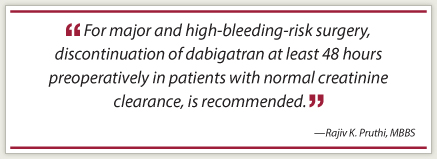Efficacy and safety of traditional anticoagulants (eg, vitamin K antagonists) are well recognized, given their long-standing use in clinical practice. However, the novel anticoagulants have several potential advantages over the vitamin K antagonists. Even so, in light of their recent introduction into clinical practice, lack of widespread understanding of their pharmacologic characteristics, and lack of long-term safety data, their use should be undertaken with caution.
 Dabigatran etexilate mesylate (Pradaxa), the first novel anticoagulant to be approved by the FDA, is indicated to reduce the risk of stroke and systemic embolism in patients with nonvalvular atrial fibrillation and high risk of stroke. The FDA-approved dose is 150 mg orally twice daily in patients with normal renal function and 75 mg orally twice daily for those with a creatinine clearance rate of 15 to 50 mL/min. Currently, there are no dosing guidelines for patients with creatinine clearance < 15 mL/min or patients who are dialysis-dependent.
Dabigatran etexilate mesylate (Pradaxa), the first novel anticoagulant to be approved by the FDA, is indicated to reduce the risk of stroke and systemic embolism in patients with nonvalvular atrial fibrillation and high risk of stroke. The FDA-approved dose is 150 mg orally twice daily in patients with normal renal function and 75 mg orally twice daily for those with a creatinine clearance rate of 15 to 50 mL/min. Currently, there are no dosing guidelines for patients with creatinine clearance < 15 mL/min or patients who are dialysis-dependent.
RE-LY Trial
The FDA approval was based on the RE-LY trial (Randomized Evaluation of Long-term Anticoagulant Therapy), a noninferiority trial of over 18,000 patients in which patients were randomized to either dabigatran etexilate (110 or 150 mg orally twice daily) or to adjusted-dose warfarin (international normalized ratio [INR] target 2–3). Overall, dabigatran was noninferior to warfarin in prevention of stroke and in reducing risk of hemorrhage.1 In anticoagulation trials, the primary aim is to reduce the risk of thromboembolism; this risk reduction is generally accompanied by an increased risk of hemorrhage. Thus, it is important to know which subsets of patients benefitted from being on dabigatran compared to warfarin.
In this trial, quality of anticoagulation control with warfarin was defined as percentage of time the patients’ INRs were within target range, and these values were stratified into quartiles (< 57.1%, 57.1% to 65.5%, 65.5% to 72.6%, and > 72.6%), with the latter two quartiles representing good and excellent control.2 Superiority of dabigatran (150 mg twice daily) in reducing the risk of nonhemorrhagic stroke was demonstrable predominantly in moderately or poorly controlled patients (INR within target range < 65% of the time). In the group of patients with well controlled INRs, dabigatran was not superior for nonhemorrhagic stroke.
 Nonhemorrhagic toxicity included dyspepsia, which occurred in approximately 10% of patients on dabigatran compared to approximately 5% of patients on warfarin and was the most common reason for discontinuation of dabigatran (21% discontinued dabagatrin vs 17% who discontinued warfarin). Myocardial infarction occurred slightly more often in patients on dabigatran (~0.7%) than in those on warfarin (0.53%).
Nonhemorrhagic toxicity included dyspepsia, which occurred in approximately 10% of patients on dabigatran compared to approximately 5% of patients on warfarin and was the most common reason for discontinuation of dabigatran (21% discontinued dabagatrin vs 17% who discontinued warfarin). Myocardial infarction occurred slightly more often in patients on dabigatran (~0.7%) than in those on warfarin (0.53%).
The overall rates of major hemorrhage were not significantly different—approximately 3% for either anticoagulant—with patients on antiplatelet agents having a higher risk of bleeding. Subset analysis demonstrated that patient’s on dabigatran had significantly lower rates of intracranial hemorrhage (0.1%) compared with warfarin (0.38%), irrespective of patient age, but higher rates of gastrointestinal hemorrhage. It is critical to note that patients > 75 years of age had higher rates of major and extracranial hemorrhage on dabigatran compared to warfarin. Thus, in this trial, the net clinical benefit (balancing the risks of thrombosis and hemorrhage) of dabigatran was greatest mainly in patients under age 75 years and in those with poor INR control.
Warnings and Precautions
Dabigatran etexilate’s optimal absorption requires gastric acidity; however, dose modification is not required for patients on proton pump inhibitors. Hepatic activation to its active form, dabigatran, results in peak plasma concentrations at approximately 1 to 2 hours after oral administration and a mean terminal half-life of between 9 and 13 hours, with approximately 80% of the drug cleared renally. Unlike with warfarin, drug interactions do not occur with agents metabolized by the cytochrome P450 enzyme complex. However, p-glycoprotein transporter inhibitors (eg, amiodarone, verapamil, or quinidine) increase dabigatran levels, and p-glycoprotein inducers (eg, rifampin) reduce dabigatran levels. Currently, there are no dosage adjustment guidelines available for patients who need one of the aforementioned drugs and dabigatran.
For major and high-bleeding-risk surgery, discontinuation of dabigatran at least 48 hours preoperatively in patients with normal creatinine clearance, is recommended. For those with impaired renal function, longer preoperative discontinuation periods (eg, 5 days) are appropriate. Routine preoperative coagulation testing provides no useful information, given the variable and inconsistent effect on the prothrombin time and activated partial thromboplastin time. If available, a prolonged thrombin time may indicate residual drug effect. None of the routinely available assays is predictive of risk for surgical hemorrhage.
Management of Bleeding
The approach to management of hemorrhage varies with timing of ingested dose, location, and severity of hemorrhage. Minor bleeding (eg, recurrent epistaxis) may be managed on an outpatient basis. The decision on withholding additional doses is based on the balance of risks vs benefits and requires an assessment of drug compliance (eg, to ensure that extra doses were not consumed), evaluation of possible changes in renal function (estimation of creatinine clearance), and a search for anatomic abnormalities that may explain the hemorrhage. Major bleeding generally requires inpatient management, institution of general and specific measures, and potentially mobilization of a multidisciplinary health-care team including, for example, specialists in nephrology, gastroenterology, surgery, and interventional radiology.
General measures for hemorrhage include holding dabigatran, attention to and management of hemodynamic stability, and a search for anatomic defects that may explain hemorrhage (such as gastrointestinal ulcers that may be amenable to endoscopic control). Aside from packed red blood cell transfusions as indicated, empiric fresh frozen plasma transfusion is not advised—the prolonged clotting times are a reflection of factor inhibition and not deficiency.
Activated charcoal is effective in cases of recent dabigatran ingestion. In addition, hemodialysis effectively removes 60% of dabigatran over a 2- to 3-hour dialysis session. However, given its extensive volume of distribution (50–70 L), a “rebound” increase in dabigatran plasma levels may occur after hemodialysis.
There is currently no antidote to dabigatran, and procoagulant hemostatic agents such as recombinant factor VIIa or activated prothrombin complex concentrates have no effect on in vitro clotting times. Moreover, there is no published evidence of clinical benefit when such agents are infused in the bleeding patient on dabigatran.
Recommendations
Although clinical trials of primary and secondary prevention and treatment of venous thromboembolism have been published,4 dabigatran is currently not FDA-approved for these indications. Pending availability of long-term safety data (eg, slightly increased risk of myocardial infarction), off-label uses (eg, secondary prophylaxis of venous thromboembolism in patients with and without malignancies, and use in mechanical heart valves) should be undertaken with caution. At the present time, dabigatran should not routinely replace warfarin or low molecular weight heparin in prophylaxis of venous thromboembolism in patients with cancer.
So, in this environment of direct-to-consumer advertising, how does one apply the current state of knowledge about dabigatran to management of the atrial fibrillation patient already on warfarin and those who are warfarin-naive? For the former patient, it depends on the quality of INR control. As recently outlined by the American College of Cardiology Foundation/American Heart Association, patients on warfarin with excellent INR control would have little to gain by switching to dabigatran.3 For patients with moderate to poor INR control who are young (< 75 years of age), a balanced and detailed discussion on the risks, benefits, and options for management of hemorrhage should be undertaken in a shared decision-making process. ■
Disclosure: Dr. Pruthi reported no potential conflicts of interest.
Dr. Pruthi is Associate Professor, Mayo Clinic College of Medicine, Mayo Comprehensive Hemophilia Center Department of Internal Medicine/Hematology Special Coagulation Laboratory, Department of Laboratory Medicine and Hematopathology, Mayo Clinic, Rochester, Minnesota.
References
1. Connolly SJ, Ezekowitz MD, Yusuf S, et al: Dabigatran versus warfarin in patients with atrial fibrillation. N Engl J Med 361:1139-1151, 2009.
2. Wallentin L, Yusuf S, Ezekowitz MD, et al: Efficacy and safety of dabigatran compared with warfarin at different levels of international normalised ratio control for stroke prevention in atrial fibrillation: an analysis of the RE-LY trial. Lancet 376:975-983, 2010.
3. Wann LS, Curtis AB, Ellenbogen KA, et al: 2011 ACCF/AHA/HRS focused update on the management of patients with atrial fibrillation (update on dabigatran): A report of the American College of Cardiology Foundation/American Heart Association Task Force on practice guidelines. J Am Coll Cardiol 57:1330-1337, 2011.
4. Bauer KA: Recent progress in anticoagulant therapy: Oral direct inhibitors of thrombin and factor Xa. J Thromb Haemost 9(suppl 1):12-19, 2011.

